Despite what the DPR said and concluded, as a loyal Pentax user myself, I recently have acquired the Pentax WG-1 GPS.
Regarding the IQ comments on the tested adventure cameras by the DPR, I actually scratched my head hard when I downloaded the full samples and inspected, which I found quite the opposite than what they have concluded and written in words.
The WG-1 has one of the few non-periscopic lens design that you can find on the market for such a "tough" digital camera for adventure, of which I have more faith for the optical quality, especially for the more accurate alignment of the optical axis and without the adoption of mirrors in the optical path for image formation.
So, here it is. Let me show you a modelling photo of my new toy and gear, first of all:-
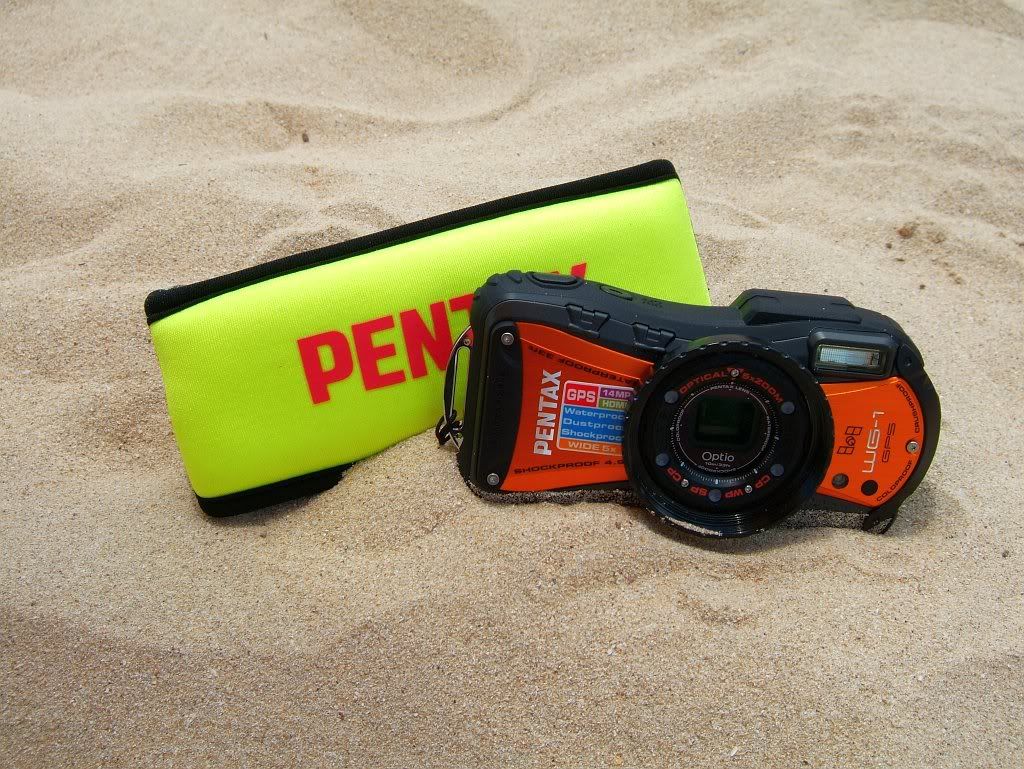
(Above: My new Pentax WG-1 GPS Shiny Orange with original Pentax Floating Strap; Click to Expand)
The Cost and What's Bundled
The above set has costed me about (US)$370, with also a 8GB Kingston Class 4 SD card, a monitor protective film (anti-reflective also) and an additional 3rd party Japanese made spare Lithium battery. It is interesting to note from the 3rd party replacement battery model that it is actually marked as a Nikon (EN-EL19) battery alternative but no Pentax model of any is mentioned, but it is just the same and fully compatible!
As you can learn from the official Pentax pages, there are also the standard accessories of backpack hook/strap and a digital microscope stand, which you can see in the above that I mounted it onto my WG-1 simply for use as the lens hood, which prevent stray light from entering into the protective glass and camera lens quite effectively in practical sense. Mounting and detaching the "hood" is quick and easy but yet it is fairly securely mounted, although I would not say it is firmly. I have swum for about half an hour on and off with the camera at my arm or wrist in the sea and the hood was still there~ ;-)
Btw, it should be noted that the floating strap is separately sold, nonetheless. It seems that this original accessory is uniquely made by Pentax and others don't have it. While the extra is paid, I think it is a very useful piece of accessory for preventing the camera to sink to the bottom of the sea accidentally once ungripped. But reversely, it will float up to the sea surface during diving if accidentally ungripped! ;-) So, it all depends!
Build Quality and QC Level
The quality and build of the camera is indeed impressive and it gave me a solid and reliable feel. The colour and appearance of it is appealing and Pentax is standing out of the crowd again as long as outer appearance and colours are counted! However, if you really want to buy, you still have to be careful about the Quality of this camera. The first camera I inspected was completely brand new out of the box but it contained a hot/stuck pixel in the sensor, as it appeared as a blinking green dot in the LiveView mode but not in user menu. The sales person then opened another box, I checked roughly for a while and no problem was spot then.
The WG-1 / GPS units are made in Vietnam:-
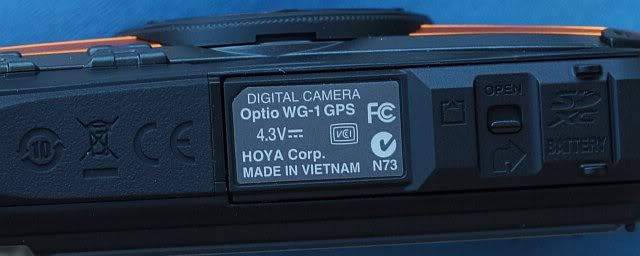
Putting aside the defect I've found in the first brand new unit, the QC of the WG-1 seems to be good enough and the glass elements inside the lens is very clean and there is not any misalignment or obvious play for the mechanical parts of the camera itself, i.e., the units are well assembled. It is funny (actually ridiculous) that the lens and optics of a Pentax P&S DC is far cleaner than the Pentax DA Limited lens, despite both are made in Vietnam at (the same?) Pentax factory?! >:-(
Operation and User Friendliness
So, about the user friendliness then. I have not much to say about it in short, as any Pentax camera, it is easy and straight-forward to use and the user should have little difficulties to use it, even for novices, I believe.
As for the exposure modes, there are a wide variety of different scene modes but there is no semi-auto (A or S) nor manual mode (M) neither. But this is not really important for a DC of such.
The LCD Monitor
The 16:9 monitor is bright but coarse. The colour accuracy and viewing angle are both average, though. It has an original high quality anti-reflective film which looks nice.
I had no problem to view the picture and compose framing even under direct sunlight and even I was wearing sun-glasses. For still picture taking, the 4:3 frame size is smaller than the total display area of the whole monitor, and the shooting information is displayed at the left side.
There is a clever power saving feature for the LCD display, too. After some time (default 5s), the display brightness will be dimmed and thus saving power. Press to any button will resume normal lighting level.
The Lens
As for the zoom lens, it is a 5X optical zoom with aperture from f/3.5 to 5.5. The zooming mechanism is internal and nearly completely silent. The zooming action is responsive and fast enough.
The coating of the lens itself in in deep green colour despite it is not marked as SMC. The flare control of this lens is average. With high contrast scenes, some light leakage can be seen across the bright and dark borders, which you could see them in some of those samples posted below.
There is no lens cover or shutter for the camera. Instead, there is a flat protective glass and shield in front of the lens. The protective glass has also some kind of anti-reflection coating but it is not as deep as that of the lens, but yet this protective glass is found to be very easy to clean and is "slippy" enough to get rid of most water droplets that come in touch.
The Image Quality
As for the Image Quality, the camera is just a P&S. Don't expect much from a 1/2.3" sensor anyway! But as for a normal DC of the same sensor size, I do actually find that the IQ of the WG-1 is not that bad at all. At least it is better than the IQ of other current adventure cameras of other brands from what I could see from various different samples as posted in the Internet.
First of all, the compression option of the JPEG (there is no RAW for the camera) should be set to finest, i.e., three stars. The factory default setting is in two stars but I do find some IQ difference between the three stars and two stars. To obtain the optimal IQ for the pictures, I strong recommend that any WG-1 user should select the three stars option.
To begin the measurbation for those ISO pixel peeper (me myself too! ;-)), I would like to post two large size samples to begin with. This was my breakfast of the day. The first photo was taken without flash under ambient light at ISO 400, the second one was made on the same subject but with the flash fired, at ISO 250 (Auto ISO):-


(Click to Download Large Images; Warning: Large Files; Picture Left: ISO 400 / No Flash; Picture Right: ISO 250 w/ Flash)
Actually, I like the colour response of the camera, the AWB is a bit yellowish under yellow light, though. I simply use the P exposure mode in which I can manually choose the Image Tone to "Bright" (The default "Auto Pict." Green mode can't). It seems that this colour response is quite favourable, at least to my own taste. The overall IQ is indeed quite good (to acceptable for some cases) for a P&S DC, which I think is a good thing afterall. The picture information indeed is preserved quite well, with a little bit simple image processing and retouch, the pictures could be quite nice. To show the potential of this camera, please see the samples below. The thumbnail pictures are retouched and enhanced semi-automatically using the batch processing of the IrfanViewer (Yes, I am just too lazy) and the large image files are all un-retouched (Click to Expand and Download. And, you can compare the difference):-
A few outdoor samples at the beach below (ISO 80):-



(Just ignore the two bigger water droplets, which were attached on the lens front and finally appear in the recorded image of the centre sample!~)
And also two more close-up food photos (at ISO 400):-


The noise is helpless anyway, even at ISO80 obvious small grains can be found at the blue sky, say. But after all, what should we expect for such a small sensor? The good thing is that at ISO400, I think the images produced are still usable, although the image details and sharpness do suffer a bit with some loss.
One thing to note about the optional setting on IQ is the "IQ enchancer" feature, which is turned on by default. I found that is something similar to the "Fine Sharpness" setting in the later Pentax DSLRs. But for noisy images, I don't prefer to turn on this option as it will cause strange sharpening artifacts and would also increase noise (for already somehow noisy images). With the IQ enhancer turned off, the images actually do look more natural. There is no noise reduction option available in the setting menu, but I believe aggressive NR is forced anyway owing to the noisy sensor. As for other image settings for highlight and shadow compensation, my advice is to avoid these as far as possible. Indeed, even when using Pentax DSLRs, turning on those functions do no good to the overall picture quality/IQ, IMHO.
The Flash
The flash is tiny but it works in a P-TTL alike mode, i.e., a pre-flash is fired for flash metering before the actually flash exposure is to be made. Unfortunately, the WG-1's flash seems to be under-powered and after the pre-flash it does need some time to recover before it can fire the final flash light. This cause a significant delay and time lag in exposure. Even worse, the pre-flash is somehow too strong so that the eyes of the subject persons are irritated and closed, resulting in lazy eyes in final taken photos. :-(
Other than the above time lag and lazy eyes problems, the flash exposure seems to be accurate and it balances well with the ambient and background light.
System Response
The system/shutter time lag of the WG-1 is typical for a P&S DC, that is, it is not too fast and not too sluggish. Yet it is manageable if you could predict the object and manoeuvre the camera with proper AF techniques, even it is moving. An example work shown below, single AF mode was used:-
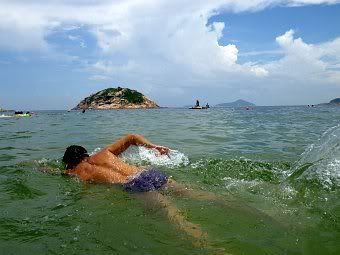
Focusing Speed
The focusing speed of the WG-1 is yet again not too fast but not too slow. The face detection of it is quite insensitive and is slow to detect, I would say.
But there is one interesting focus mode option for the moving object. I haven't tried to use it anyway. Maybe it is just a ground-breaking brand new technology of Pentax then if it really works! Why? Have you ever heard that any CDAF from any manufacturer can do continuous servo AF with good results? I am afraid not! :-(
And yes, my Fuji F810 also had a C-AF for a DC, but I am afraid that that C-AF is just Single AF that in a Continuous loop! :-o
Focusing Accuracy
The focusing accuracy of the WG-1 is fair to good, but don't expect razor sharp focusing with the AF for each picture! :-o
The GPS Performance (Sensitivity, Speed and Accuracy)
The GPS data is slow to detect and of low sensitivity/availability. I think both my iPad and my Nokia mobile phone are doing better in term of these. But the location accuracy (for the latitude and longitude) of the Pentax/WG-1 GPS is very high and it is really amazing. See the following OpenStreetMap. By looking back at the original photo, I am almost sure that I was just there, quite exactly:-

But it should be noted that whilst the hit rate of an accurate GPS location is fairly high, it is yet not perfect, sometimes it is still somehow off for some of my photos taken (in a small proportion).
The altitude error and deviation is much larger, nevertheless. For my photos taken at the beach, all should show sea level reading, i.e., the ideal reading should be 0 metre. But however, for those photos, the reading ranged from 1.9m at best up to a height at 40m something, which just indicate a large random error of the altitude measurement.
The SR Function
The SR function is not a hardware sensor-shifted one, but a "Pixel Track" (for what Pentax calls it) software-based processing. It is turned off by default, but I turned it on anyway. But it seems that Pentax has little confidence on the performance of it. Otherwise it won't be turned off by default as the factory setting. From my own experience, it seems that there is no adverse impact to IQ under normal shooting. On a tripod, as any image stabilisation function, it is recommended that which should be switched off.
More Samples
Same as above, the thumbnail photos are semi-automatically enhanced in batch and the large photos are not. To download the 100% original full photos, you have to do it at individual Photobucket picture page and select it from the Option menu:-
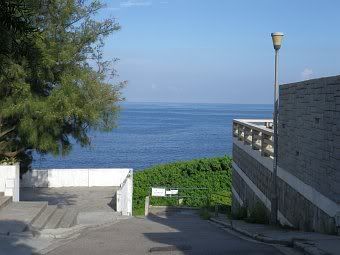

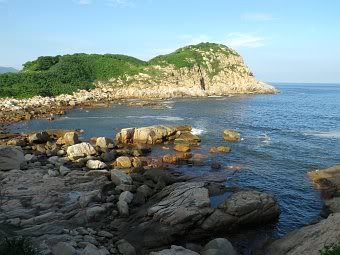
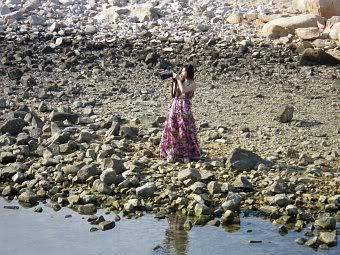
Video Quality and Issue
The video of the WG-1 is the weakest link of it, I am afraid. Not only the ageing Motion JPEG in AVI in 720p, and not just the mono-sound single channel recording, but the worst thing is about its video quality. The sound quality is somehow okay but the video quality is really inferior. The colour rendition is strange and video picture is noisy plus image are really coarse (so the 720p is just meaningless - it does much inferior than my Sony NEX which is also in 720p). Motion is not smooth even though there is already no motion compression of any and the CCD sensor often suffers much from light charge flooding/overflow (also known as CCD bleeding/smear) when stronger highlights appear in frame. Under those situation, terrible vertical bright/colour lines will appear as a result. In other less severely affected cases, terrible banding noise is resulted.
Side Note - Quick Tip about the Engagement of the Video Recording Mode:-
There is not a dedicated video recording button on the camera, but the "green button" is programmable as a quick key to enter into or leaving the movie mode. Actually, it is still fast and easy to use, but of course not as convenient as a dedicated recording button, like what we can find in many other DCs nowadays. Besides, once programmed like this, the green button is yet somehow easy to be accidentally pushed which actually happened for a few time when I was in the water while holding the camera, it would toggle between still picture and movie mode unconsciously, which is indeed undesirable.
Battery Life
The battery life of the WG-1 GPS is good enough. I have used the camera for 8 hours on and off with some extensive reviewing for a few times. I had also the GPS function turned on for the whole day. When I came back to home, there was still little battery juice left.
It should be noted that, as stated in the user manual, that the GPS function, once selected, is always working (searching), even when the camera is switched off. So, this would inevitably consume and drain some battery power from time to time. So, the tip is yet one should remember to turn the GPS function off when it is not needed, otherwise the battery juice will be drained completely eventually.
Cleaning and Maintenance After Use
As per the user manual instruction, after use in dirty environment, the camera should be fully washed and then immersed in clean tap water afterwards as recommended. This was what I did:-
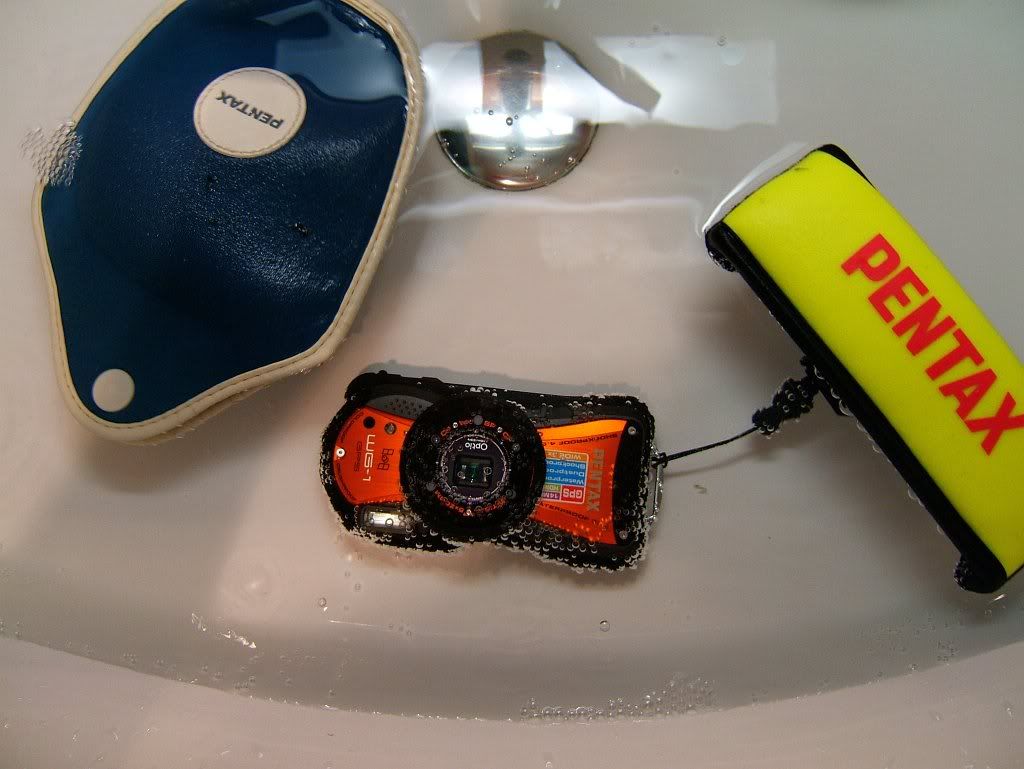
(Click to Expand)
After drying, I wiped the front protective optical glass and the LCD monitor of the camera with a lens cloth and put it back into my electronic dry cabinet.
Conclusion
All in all, I am quite satisfied with the WG-1 GPS. It has got the job done quite well for what it is designed and I do think that it worths for what I've paid. Btw, I think this is the most satisfied Pentax purchase these ten years since my last purchase on my Pentax film SLR flagship MZ-S! So, Highly Recommended! ;-D
Update (9-28): New Sample Photos and a Video Clip Added.
Other Related Articles:-
"Where There's Water There is Pentax"! :-o
DC Watch Tough DC Shootout
The State of Pentax (by Q1 2011)
Pentax Optio WG-1 / GPS